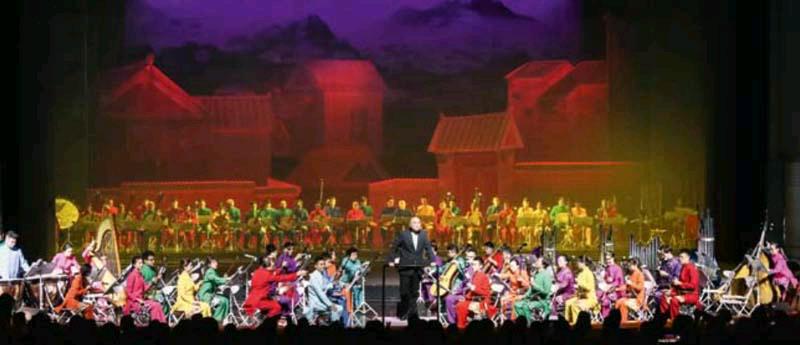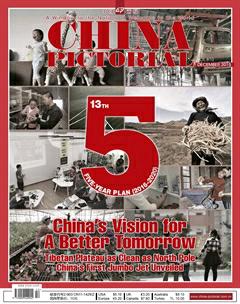Rebirth of National Music:Rediscovery of Classical Chinese Folk Music
by+Zhong+Yan
Known as “Chinese national musical,” Rebirth of National Music combines plot and story-telling into a performance. Musicians play the parts of legendary characters so that the audience can hear the music and, at the same time, follow the stories and figures behind the music. Its crossover rendering on stage makes Rebirth of National Music a journey of rediscovery of classical Chinese folk music.
Innovative Expression of Traditional Music
The nine pieces of folk music show the traditional Chinese understanding of various issues related to our outlook on life, including friendship, heroism, homesickness, and farewell. A typical Chinese friendship is illustrated in High Mountains and Flowing Waters that extols the rela- tionship between Bo Ya, a qin player, and Zhong Ziqi, a woodcutter, in the Spring and Autumn Period (770-476 BC); the typical Chinese hero and his pathos and helplessness is displayed in Ambush from Ten Sides when Xiang Yu, Overlord of Western Chu, though famous for his boldness and power, finally sank into a state of depression; Chinese homesickness is exhibited in A Moonlit Night on the Spring River, wherein is portrayed the characters deep yearning for a better future in his hometown in the region south of the Yangtze River in a spring night; and, the typical Chinese farewell is depicted in Parting at the Yangguan Pass, just like the heroic and unrestrained expression in “I invite you to drink a cup of wine again; West of the Sunny Pass no more friends will be seen.”Each piece was originally the representative work of traditional Chinese musical instruments. High Mountains and Flowing Waters is the solo of guqin, a sevenstringed plucked instrument in some ways similar to the zither; in Three Variations of the Plum Blossoms, guqin is played in harmony with xun, an ancient egg-shaped, holed wind instrument, and xiao, a vertical bamboo flute; in Ambush from Ten Sides, one pipa, a plucked string instrument with a fretted fingerboard, is played against another; and in A Moonlit Night on the Spring River, pipa is played together with xiao. All these musical instruments have a history of thousands of years. For instance, guqin has a history of over 2,000 years; xun, which is ceramic, is said to have a history of over 7,000 years. Our ancestors made instruments like xiao with bones in ancient times; and pipa, the most famous plucked string instrument, also traces its history to 2,000 years ago. Rebirth of Na- tional Music features these musical instruments, linking us and the spiritual culture of ancient people.
Furthermore, it is a novel combination of 10 classical pieces rendered with freshness. For instance, in terms of musical arrangement, Jiang Ying changed the pipa solo in Ambush from Ten Sides into pipa ensemble, to vividly describe the confrontation between Liu Bang and Xiang Yu, and to evocatively reproduce the fierce, epic battle between Chu and Western Han.
Rebirth of National Music incorporates various artistic forms in music, including film, drama, and sculpture, which is an exploratory demonstration of traditional folk music and aesthetics. The most eyecatching of all is the use of multimedia videos, which is played with the music by involving various traditional Chinese cultural images, such as Chinese ink painting, traditional architecture, and folk customs. To be more appealing, Rebirth of National Music breaks the fixed stage positions of traditional orchestra. The whole performance catches the audience by surprise: Sometimes, the solo player blends into the visual stage design; at other times, the players of plucked string instruments line up on the entablature; and, sometimes, the whole band suddenly rises from the orchestra pit to appear on stage. Here, traditional Chinese music is no longer a historical relic on paper; it comes alive vividly.
Decoder of 5,000-Year Civilization
As a new classic, Rebirth of National Music is the collaborative work of Wang Chaoge, a renowned director and the only female among six in the core creative team of the opening and closing ceremonies of 2008 Beijing Olympic Games, and the China National Orchestra. Wang is the legendary forerunner in real landscape performance. Since Impression: Liu Sanjie in 2004, she has perfectly integrated the Chinese landscape culture and business operation mode and created a series of outdoor folk musicals under the title Impression, which has now become a 1-billionyuan industry. Although she was wooed by various prospective investors, she made an astonishing decision in 2003 — to accept the invitation from the China National Orchestra. She created a new piece of the Impression series called Impression: Traditional Chinese Music for a token payment of one yuan, which added a new dimension to this tradition. In 2015, in collaboration with China National Orchestras artists, again for a token two yuan, she produced Rebirth of National Music as a tribute to the classics.
In Rebirth of National Music, Wang Chaoge worked with Jiang Ying of the China National Orchestra and, thereby rediscovered the traditional Chinese music and culture behind it. In their creation, the young composer Jiang Ying injected contemporary elements into classical pieces, which not only added a modern romantic feel and poetic flavor to the traditional, but also reflected Chinese cultural and historical context. The two artists created Rebirth of National Music with the China National Orchestra and select masters of folk music. They reshaped perceptions of traditional Chinese folk music with innovative and ground-breaking methods to strike a chord among contemporary audiences with the grand beauty in music.

